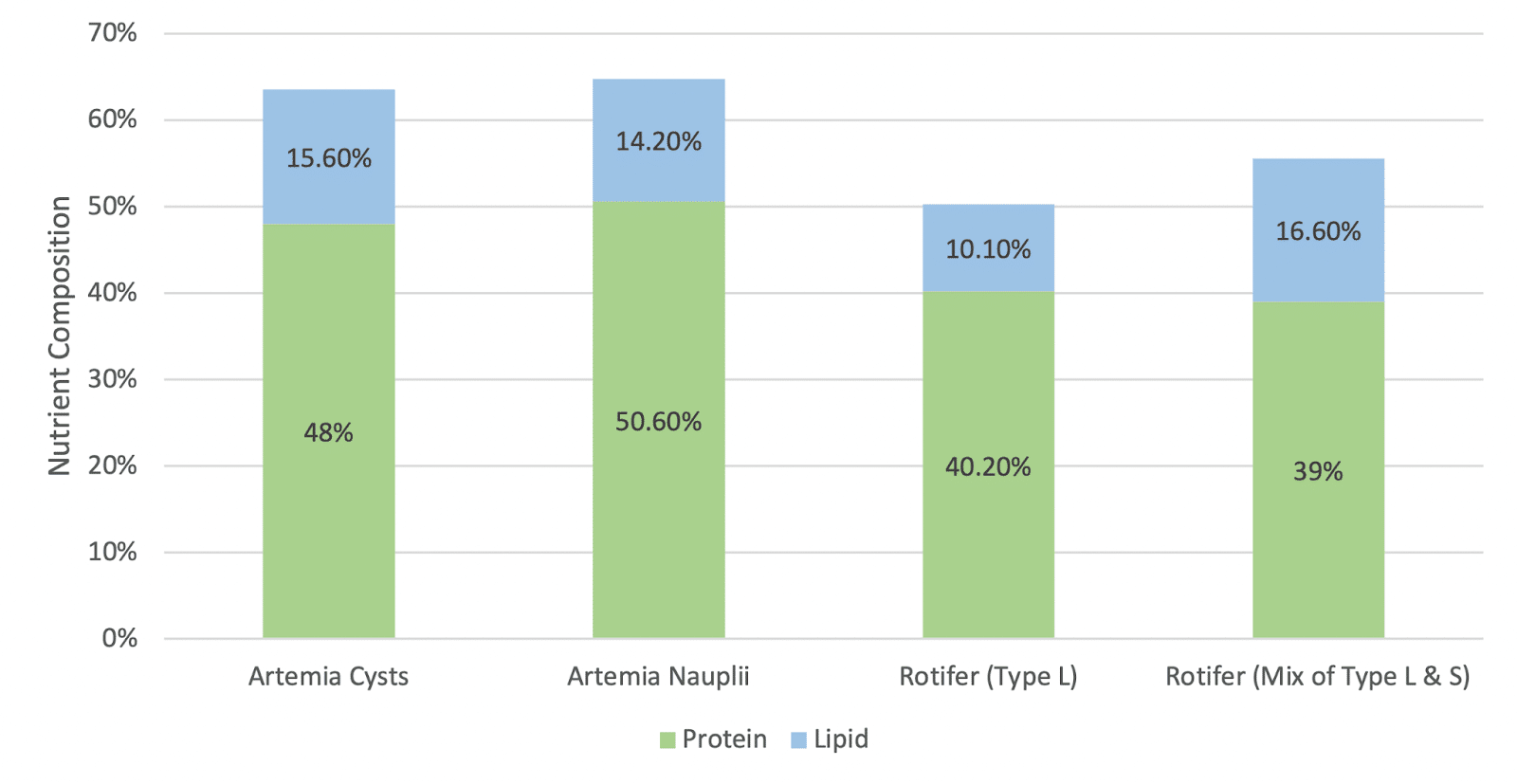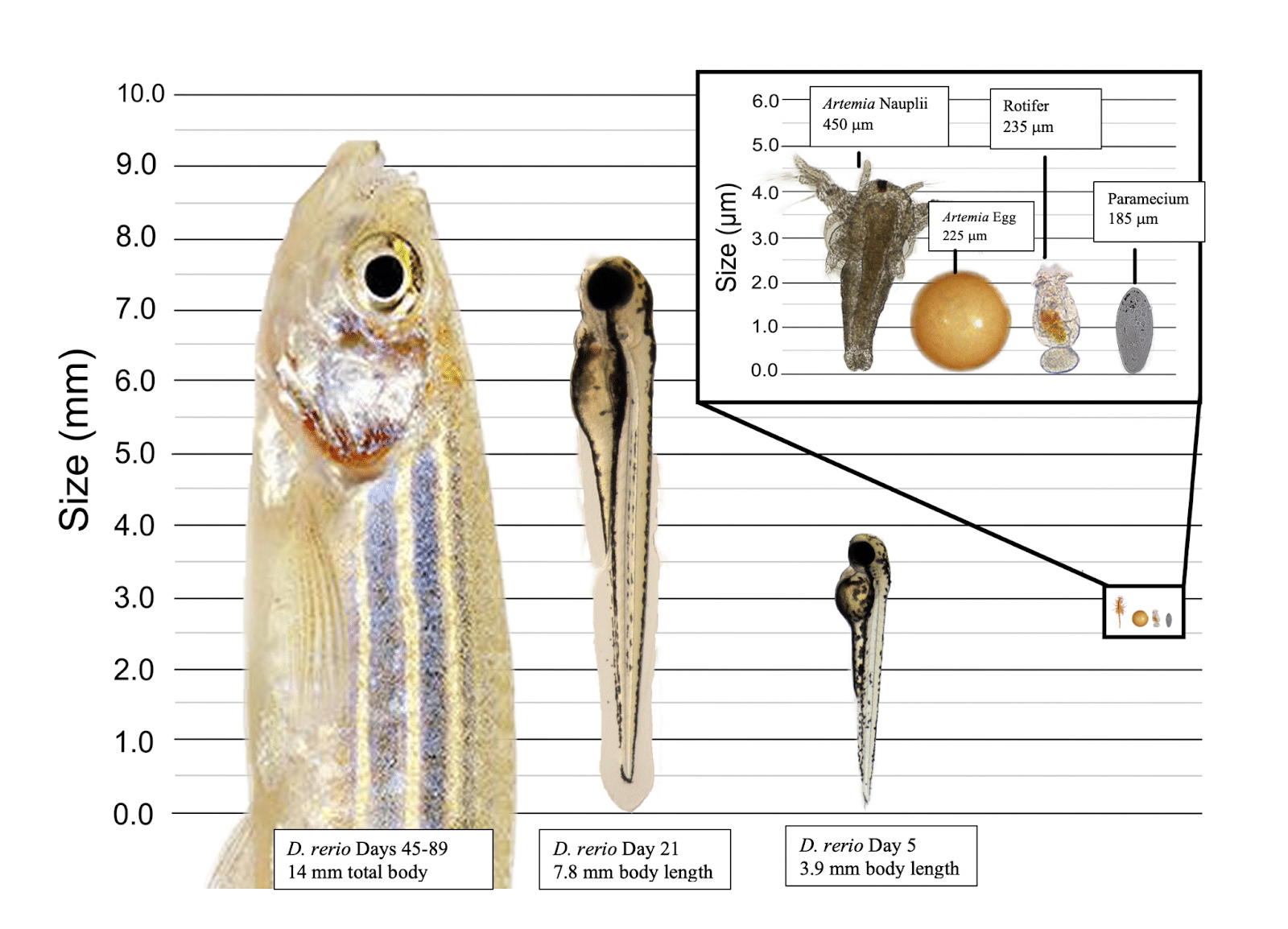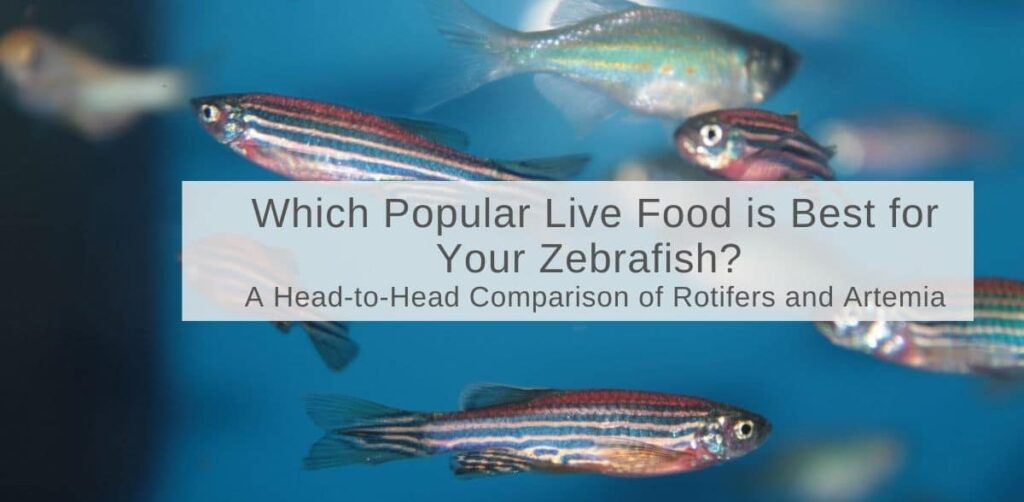The zebrafish (Danio rerio) is a relatively newer model organism that is rapidly growing in popularity, thanks in part to the benefits of using it for research on human diseases. The main factors that have popularized zebrafish in the field of human disease research include:
- They produce large numbers of offspring
- Their offspring develop quickly
- They are a vertebrate model with high genomic similarity to humans
When choosing the right food for a Danio rerio colony there are a number of factors to consider. This guide will help navigate the roadblocks of live food selection. These challenges are split into two main categories: First level factors and second level factors.
First Level Factors: These are the factors that immediately impact fish eating & wellbeing. For example, are the larvae able to physically eat the food?
Examples include:
- Food size
- Availability 24/7
- Nutritional Content
Second Level Factors: Consider other effects of the chosen food on the ZF colony & labor required.
Examples include:
- Colony exposure to pathogens and parasites
- Live food containing heavy metals/mutagens
- Effort and resources required to maintain colony
When choosing a food, you need to be clear about your top priorities for your food selection: Do you want a food with 24/7 availability? A live food that is easy to maintain? A smaller sized food? After coming up with top priorities, one should also weigh the effects and potential risks of the live food on a colony.
While other established model organisms like Drosophila melanogaster have standardized diets, D. rerio diets may vary from lab to lab. While the zebrafish is gaining popularity in labs, there is still a lot to understand about its the nutritional needs. This material will give you some insight into less commonly considered factors when choosing between popular live foods.
First Level Factors:
Nutritional composition is an example of a first level factor. There are 2 common types of live feed used in D. rerio diets: rotifers, and Artemia. The nutrient composition varies between these two species, but both are good choices. There is a tight link between D. rerio diets high in 1) protein and 2) lipids and weight gain & healthy progeny (Kolb et al., 2018). The daily protein requirement for D. rerio is 14 mg/g average body weight/day (Fernandes et al., 2016).

Because of this, one might lean towards Artemia as both cysts and nauplii tend to have a higher composition of protein and lipid. However, consider other factors like the size and age of your D. rerio. A small sized fry may choke and/or die if a food size is too large. Alternatively, young fish may be too slow to catch faster prey like Artemia. It may be beneficial to feed your fry a smaller size food (like rotifers) and transition to larger/faster food (like Artemia) as your fish mature (Chapter 3 – Embryonic and Larval Culture). For a scaled reference showing the size difference between different live foods refer to the infographic below.

Within these common live food species there are sub categories. For example there are two prominent species of rotifers used as live food: L type (Brachionus plicatilis) and S type (Brachionus rotundiformis). S type is smaller than L type and might be easier to feed to younger fish. Artemia comes in two popular forms: decapsulated eggs and nauplii. Nauplii may enrich your fish through hunting behavior, but decapsulated eggs take less work to maintain. There are a lot of small choices to make when choosing the right food.
Live food is only as good as you make it
A benefit of rotifers over Artemia is their ability to gut load. One may put rotifers in a saturated algae culture for a period of time before feeding to zebrafish fry. This ensures that the rotifers that the fry eat contain an increased amount of nutrients from the algae.
Second Level Factors
Culturing live foods for zebrafish raises the concerns of many other second level factors. For example, live foods may introduce pathogens and parasites into your colony. Additionally species you outsource may contain heavy metals affecting your colony’s progeny (Tye et al., 2018). Live foods also require more time to upkeep than dry foods. While some of these risks may be an unavoidable price of using live food, others can be mitigated by sourcing your food from a reputable seller.
Both Rotifers and Artemia are grown in an aerated salt water environment. Rotifer cultures may require a larger amount of energy to start and maintain, however in the long run both Rotifers and Artemia are relatively low effort live food options. Both species may be grown in zebrafish facilities (typically ~26˚C-29˚C). To begin, rotifers are typically shipped live, meaning that any colony decline will require another live shipment. Alternatively, Artemia may be grown from cysts stored in the freezer which bypasses shipment time if a consistent culture is critical.
When growing Artemia, it takes 24 hours for the brine shrimp hatch out of their eggs. Often a small fraction of these cysts won’t hatch. Decapsulation is an important process as a fry may develop intestinal impactions if it consumes too many capsulated cysts. This may result in decreased health or death. Because of this, it is ideal to decapsulate Artemia cysts before feeding to your zebrafish. This process entails hydrating the cysts, dissolving the chorion using NaOH & ClO⁻, and neutralizing the process with HCl (Media). This process will increase staff workload by a small amount but has a large impact on your juvenile zebrafish survival rates.
Rotifers are grown in two main ways:
- A continuous culture: harvesting 10-20% of one big culture each day
- Batch culture: harvesting 100% of a smaller culture, multiple cultures growing at the same time.
Rotifers may be particularly sensitive to any changes in their environment such as the amount of food, consistency of aeration, etc., so it is ideal to have multiple cultures in case of a colony decline. Although this species may be challenging to begin, they provide a nutritious and enriching live food for fry when combined with gut loading and polyculture.
Conclusion
Whether your choose Rotifers and Artemia, live food can enrich your zebrafish and provide them with a bountiful source of lipids & protein. In this article we have provided some factors to consider when choosing between two popular live food species – Rotifers and Artemia. There are many benefits to both of the popular live food species for juvenile zebrafish. As there isn’t a standardized zebrafish diet yet, the food that one uses to rear zebrafish is largely based on personal preference.
References
- Chapter 3 – Embryonic and Larval Culture. The Zebrafish Information Network. (n.d.). https://zfin.org/zf_info/zfbook/chapt3/3.2.html.
- Fernandes, H., Peres, H., & Carvalho, A. P. (2016). Dietary Protein Requirement During Juvenile Growth of Zebrafish (Danio rerio). Zebrafish, 13(6), 548-555. https://doi.org/10.1089/zeb.2016.1303
- Kolb, A., Hildebrandt, F., & Lawrence, C. (2018). Effects of Diet and Social Housing on Reproductive Success in Adult Zebrafish, Danio rerio. Zebrafish, 15(5), 445-453. https://doi.org/10.1089/zeb.2018.1599
- Media, M. (n.d.). What are decapsulated brine shrimp eggs? BrineShrimpDirect. https://www.brineshrimpdirect.com/about-us/frequently-asked-questions/what-decapsulated-brine-shrimp-eggs/.
- Tye, M. T., Montgomery, J. E., Hobbs, M. R., Vanpelt, K. T., & Masino, M. A. (2018). An Adult Zebrafish Diet Contaminated with Chromium Reduces the Viability of Progeny. Zebrafish, 15(2), 179-187. https://doi.org/10.1089/zeb.2017.1514

